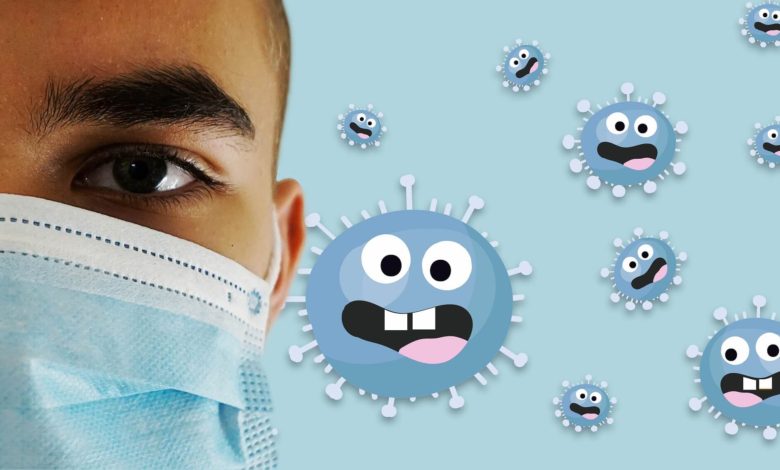How Does the Immune System Work Against Viruses?

Viruses cannot reproduce by themselves, so they rely on host cells to do this and are called intracellular parasites. Viruses are typically an RNA or DNA genome surrounded by a protective protein coat. A complete virus particle is called a virion. The simplest virions consist of their genome and a protein coat known as a capsid that protects genetic material from nucleases.
Viruses typically have a small genome size in addition to encoding a small number of structural proteins (in the capsid) and regulatory genes involved in their replication. On the other hand, other viruses have an additional coat called envelope, derived from partially modified host cell membranes. These modified membranes often have spikes called peplomers, which are composed of glycoproteins. This provides similarity to the target host cell so that the glycosylation pattern gives the antigenic specificity of the virus.
Cytotoxic Cells
Mammals have developed a refined immune system to address various types of infections. This is especially true for the adaptive immune system, where it has an important role in limiting viral infection and its clearance. After the virus infiltrates the host cells by binding to its receptors, the virus commands the host’s protein synthesis mechanism to reproduce and synthesize their proteins.
During this process, the host cell can exploit the vulnerability of the virus, where some of the newly synthesized protein fragments can be cleaved into specific peptides. If there is sufficient binding capacity, this peptide fragment will then bind to the main histocompatibility complex (MHC) -1. These MHC-1 complexes allow the peptide fragment to be presented on the surface of the infected cell, and activated cytotoxic T cells or CD8 + T cells can differentiate the specific peptide and induce apoptosis of the infected cell by cytotoxic granules.
CD8 + cells are activated in our lymph nodes where antigen presenting cells (APC) such as dendritic cells meet a pure T cell (CD4 +). During this process, CD4 + and dendritic cells provide the necessary costimulation for the activation of CD8 + cells. Despite this, viruses are highly adaptable and therefore can overcome detection by T cells. In such cases, the MHC-1 molecule can be prevented from showing viral peptides on the surface.
When this happens, the cell is unable to let the surrounding cells know that they are infected. Fortunately, when this happens, our immune system is well equipped to compensate for it. Natural killer (NK) cells are the second type of immune cell; clonally they are lymphocytes that do not have a specific receptor. Hence, they are unlike T or B cells in that they do not have an antigen-specific receptor. Previous studies have identified NK cells to target and destroy cancerous cells without prior sensitization by cytolysis.
Subsequent observations led to the development of the deficient self hypothesis that these NK cells could target tumor cells that did not show the MHC-1 complex. The lost self hypothesis predicts that the NK cell can destroy viral infected cells that can inhibit the expression of MHC-1 molecules. Recent developments have suggested that NK cells are activated and regulated via a variety of receptors. In fact, there are receptors in NK cell that can identify viral derived products. The most common viral product is hemagglutinin of an influenza virus that binds to the NKp46 receptor.
In addition to direct viral recognition, NK cells have an unusual ability to identify cellular stress signals through the NKG2 family. The NKG2D family is a critical mediator of NK cell activation. The associated ligands (ULBP and MIC in humans) have extensively studied and highlighted their role in possible viral mechanisms that might escape NKG2D recognition, such as cytomegaloviruses (CMV).
In addition, this ligand is expressed on macrophages and dendritic cells; therefore, it mediates the immune system’s interference. Once their activation and recruitment into the field of infection, NK cells can use different strategies to kill virally infected cells, these strategies are as follows:
• Interferon-gamma (IFN-y) production: IFN-y can directly exert its effects on the infected cell, making it less hospitable. It can also take on cytotoxic T lymphocytes and CD4 + cells.
• Perforin and granzymes: While perforin makes the cell membrane permeable, granzymes can disrupt cell cycle progression by DNA damage upon entry into the cell.
• Cell mediated cytolysis: NK cells express ligands that can activate the extrinsic apoptosis pathway by activating the death receptors in the infected cell.
Antibodies
Enveloped viruses common among viral families and have the potential to cause the deadliest diseases known today. They share a common component of both glycoproteins and spike proteins, allowing both entry into the cell cell recognition cell and exposure to the adaptive immune response, a target for antibodies. Antigens or spike proteins are recognized by rapidly replicating B-lymphocytes, so that B cells mature and differentiate, leading to the production and secretion of high affinity antibodies against the antigen that triggers the response.
The first IgM antibody undergoes class switching to have a high affinity and a strong response to viral infection. However, this answer is not limited to antigens alone. Following initial infection, virus particles can be broken down into components that are then exposed to the immune system. The exposure of epitopes and cryotopes allows antibodies of various specificities to be produced. This allows neutralization of the intact virus and identification of its components.
How Does The Immune System Protect From Infection?
The task of the immune system is to defend against microorganisms that cause disease and its purpose is to keep the person healthy. The immune system is a large and complex interconnected network of many different organs, cells, and proteins that work together to protect the body from disease. A healthy immune system can defeat invasive disease-causing microbes (or pathogens) such as bacteria, viruses, parasites, and cancer cells while maintaining healthy tissue. Understanding how the immune system works and how we can help protect our bodies is crucial to the fight against the COVID-19 pandemic.
There are two main parts of the immune system.
How Is The Immune System Activated?
Anything that triggers an immune response is called an antigen. An antigen can be a microbe such as virus, bacteria, toxins, chemicals or other substances from outside the body. If the body comes into contact with an antigen for the first time, it stores information about the microbe and how to fight it. If an antigen enters the body and the B cells recognize it (from having had the disease before or being vaccinated against it), B cells will produce antibodies. When antibodies attach to an antigen (think of a lock – key configuration), it signals other parts of the immune system to attack and destroy invaders. This is when the human body develops immunity (acquired) against a particular disease. However, some microbes and viruses are very compatible. Over time, they find ways to change and sneak into our bodies, so flu vaccines are recommended every year.
Why Are Vaccines Important?
Vaccines stimulate the immune system to make disease-fighting antibodies, which benefit from acquired immunity without the person having to get sick first. They do this by introducing antigens into the body in the form of an inactivated or killed virus to stimulate the immune system. Exposing the body to antigens triggers an immune response and antibody production, which can lead to a lasting memory that can help fight infections in the future.
Innate immunity is the inherited immune system and is active immediately at birth. It consists mainly of physical barriers on and within the body. There are also special immune cells that quickly attack pathogens entering the body. The main characteristic of the innate immune system is its rapid response, which can lead to inflammation and fever. It does not recognize certain types of bacteria or viruses; it attacks widely, so it cannot get rid of all pathogens.
The immune system also learns, this is called acquired or adaptive immunity. When the immune system is exposed to a new microbe for the first time, it reacts by trying to fight it, which means it may be sick. Only then will the immune cells remember the invader and be better equipped to fight it if it returns.





